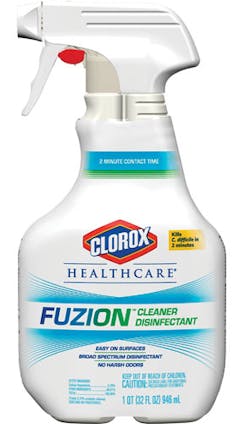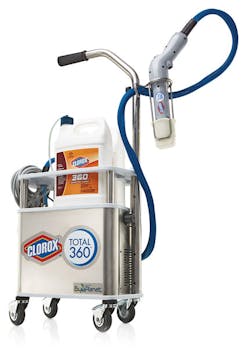Infection-prevention and –control professionals are on the front-lines everyday fighting one of the most harmful enemies their patients will ever encounter: healthcare-associated infections (HAIs). It’s no easy task, but when clinical teams follow evidence-based guidelines and practices, engage facility-wide cooperation in the effort, and adopt products and services that are proven to work, healthcare providers do succeed. It’s also important to keep in mind that every positive outcome matters. In fact, no favorable change in infection rates is too small to consider important in this battle because every life saved counts, and every bit of suffering reduced is monumental. Here’s a snapshot of what clinical teams working in healthcare organizations across the country are doing to help keep their patients infection-free and on their way to a better healing experience.
Helping hand-hygiene adherence
New Jersey
Atlantic Health System (AHS) serves a population of five million, with over 400 sites of care, including six hospitals: Morristown Medical Center, Overlook Medical Center, Newton Medical Center, Chilton Medical Center, Hackettstown Medical Center, and Goryeb Children’s Hospital.
AHS’s goal was to reduce their overall HAI rate by focusing on increasing the rate of hand-hygiene (HH)–compliance. “We wanted to get a stronger handle on preventing infection and ensuring our staff understood and took advantage of every HH moment throughout their shifts,” noted Laura Anderson, MSN, RN, CIC, Director, Infection Prevention. “Hand-hygiene compliance rates were difficult to track with the auditing system we had been using.”
What they did: In July 2015, AHS implemented the DebMed Electronic Hand Hygiene Compliance Monitoring System, from SC Johnson Professional, in targeted units that had higher infection rates at their hospitals, particularly Clostridium difficile (C. diff). “We found the DebMed Electronic Hand Hygiene Compliance Monitoring System great for educating staff on all necessary HH moments as well as for holding staff accountable. The data was reliable, and we received it in real-time, which meant we could give staff and managers tangible numbers to demonstrate how well they were doing.” Anderson added that this badge-free system tracks compliance based on WHO’s 5 Moments and the Centers for Disease Control and Prevention (CDC)’s HH standards.
The campaign was a team effort, with senior leadership supportive from the beginning, a key factor in its success. “Implementation was a shared effort at all sites with leadership, infection prevention, nursing, ancillary departments, information technology, and facilities. It was vital for everyone to understand that they all had a role in our HH compliance numbers. Constant discussion of rates, posting of data, and daily discussions on the nursing units was an important part of our efforts to achieve success and keep our patients safe.”
Results: “Participating units from the pilot program were not only able to increase compliance by 46.2 percent but also saw a strong connection between improvement in HH compliance and decreased infections,” noted Anderson. “Due to the success of the pilot initiative, AHS expanded use of the DebMed program to its six hospitals, achieving a sustained 57 percent improvement over baseline during a 12-month period. After implementing the DebMed Electronic Hand Hygiene Monitoring System, AHS, as a whole, is currently nearing 90 percent compliance.”
AHS has experienced a forty-seven percent decrease in catheter-associated urinary-tract infection, fifty-eight percent decrease in surgical-site infection, sixty-four percent decrease in C. diff infection, and eighty-two percent decrease in methicillin-resistant Staphylococcus aureus BSI.”
Clearing away CLABSI
Abilene, Texas
Abilene Regional Medical Center (ARMC) is a 231-bed facility with inpatient, outpatient, medical, surgical, and emergency care. It is an Accredited Chest Pain Center with PCI, and the area’s first neonatal intensive care unit.
In early 2017, ARMC’s central-line–associated bloodstream infection (CLABSI) rates were above the national benchmark and were on low Hospital Consumer Assessment of Healthcare Providers and Systems (HCAHPS) scores. Although chlorhexidine-gluconate (CHG) wipes for patient bathing were employed, CLABSI rates continued to rise.
What they did: Paulina Rodriguez, RN, Infection Preventionist, ARMC, explained the cause of the problem and how they resolved it. “We did a root-cause analysis of current practices and discovered an evidence-based infection-control strategy was not being administered by staff because patients disliked it. Staff were administering regular soap-and-water baths instead of CHG wipe downs, because patients complained about feeling sticky after using wipes and wanted a regular bath. Patients did not consider a CHG wipe down as bathing, and it gave them a feeling of dependency.
”Any strategy will succeed only if compliance is high, so we searched for alternative soap-based CHG products that would be accepted by patients and supported by staff. We eliminated basins several years ago, because they can harbor bacteria, and did not want to bring them back. This meant finding a disposable cloth.” Mölnlycke’s Hibi Universal Bathing System was chosen.
Rodriguez said that both staff and patients reacted positively to the change. They added extensive patient education on the importance of having a Hibiclens bath every day to prevent HAI. “Staff reported that patients were asking for their Hibiclens CHG baths after reading their reminder shower cards. Staff were reminded to call the bathing a ‘treatment,’ not just a bath. On the medical-surgical units, the peripherally inserted central-catheter team was involved to monitor compliance, while infection prevention audited the intensive-care units. We did this on a monthly basis.”
Results: “After eight months, CLABSI rates showed a 67.6 percent decrease over the prior year,” Rodriguez said. “In addition, in 2016 there were several possible CLABSI or BSIs that met all but one element from NHSN criteria compared to two in 2017. We have been able to sustain zero CLABSIs through 2018 per NHSN criteria. We have maintained a global Hibiclens and Hibi CHG bathing approach to all patient populations in ARMC, with continued decrease in patient complaints over bathing product.”
Rodriguez also noted that HCAHPS scores were compared before and after the bathing process change. “Prior to the practice change, patients stating on exit interviews that they had never had a bath while in the hospital had been negatively impacting our scores. Patient complaints related to bathing on post-discharge surveys have ceased, and scores have risen from pre-intervention and remained positive post-intervention.”
Big diff in C. diff
Clinton, Iowa
Nonprofit MercyOne Clinton Medical Center is a 249-bed health system serving residents in Clinton, Iowa, and surrounding communities in eastern Iowa and northwestern Illinois. It is a member of Mercy Health Network, based in Des Moines, Iowa, and is affiliated with Trinity Health, headquartered in Livonia, Michigan.
Their goal was to reduce hospital on-set (HO) C. diff infection (CDI), as part of their affiliated system’s priority strategic aims to reduce frequency of HAIs.
What they did: Chol M. Chagai, Director of Hospitality Services, and Jeff Sander-Welzien, RN, Infection Preventionist, MercyOne Clinton Medical Center, offered background on their campaign against C. diff: “Before the campaign, there were a total of twelve HO CDIs, with a Standardized Infection Ratio (SIR) of 1.705, since the beginning of 2017.”
Chagai and Sander-Welzien said they began by engaging their facility in Trinity's Environmental Services (EVS) shared service model. “This model offers a broad range of resources to Trinity facilities including training, standardized cleaning/disinfection procedures, and use of a sporicidal disinfectant, OxyCide Daily Disinfectant Cleaner from Ecolab, for all daily and discharge patient-room disinfection. OxyCide enabled standardization of cleaning procedures across all units and departments, making cleaning and disinfecting simple and straight forward.”
“Weeks before program implementation, literature, including OxyCide tent cards, was placed in patient units, waiting rooms, bathrooms, and the cafeteria, allowing stakeholders time to get educated on the product and ask questions,” noted Chagai and Sander-Welzien. “Ecolab trainers educated EVS personnel on topics such as personal protective equipment, proper mixing of chemicals, focus on high-frequency touch surfaces, proper cleaning techniques, and use of Ecolab’s DAZO monitoring program (fluorescent marking system) for room-cleaning audit, feedback, and quality assurance.”
Results: “Looking at the same period after our intervention,” said Chagai and Sander-Welzien, “HO CDI was cut in half, from 12 to 6, decreasing our SIR from 1.705 to 0.777. With ongoing service and training support from Ecolab, success has been sustained. As of November 2018, SIR remains down at 0.669, with only seven HO CDI since our intervention.”
Tupelo, Mississippi
North Mississippi Medical Center (NMMC), a 650-bed regional referral center in Tupelo, is the largest private, not-for-profit hospital in Mississippi and the largest non-metropolitan hospital in America. The center reaches 24 counties in north Mississippi, northwest Alabama, and portions of Tennessee.
Terry Hall, Healthcare Operations Manager, said, “C. diff infection cases were being reported to infection control and then established as an HAI or non-HAI, using the CDC’s criteria for national reporting purposes. A rate of one case per 1,000 bed-days was revealed as a result. Action was taken to reduce this rate significantly.”
“Starting January 2012, Bioquell Hydrogen Peroxide Vapor was utilized and reported on for the next 24 months in a strategically designed approach to reduce CDI. NMMC selected the Bioquell Proactive service, which hosts Bioquell equipment and personnel on site to perform daily decontamination in accordance with infection control’s plan. The team is still operating in the facility to this day.”
Searcy, Arkansas
Unity Health – White County Medical Center has 438 licensed beds and a medical staff of more than 150 physicians specializing in various areas of healthcare. The facility serves patients in Central Arkansas.
Meghann Holmes, RN, Infection Preventionist, outlined their mission. “Our infection rates were already low, so we didn’t have one specific target, but with a nationwide rise in C. diff and multidrug-resistant bacteria, we decided to focus our efforts there.”
What they did: “With the rise of antibiotic-resistant superbugs, we are continually investigating new technologies to keep our hospital clean and our patients safe,” said Holmes. “Before we began our campaign, we analyzed our infection data and chose the operating room and four targeted inpatient units on which to focus our efforts. In those areas, our baseline rate was 15.49 infections per 10,000 patient-days.
Results: “By the end of our first nine months utilizing three Xenex LightStrike robots,” continued Holmes, “our infection rate dropped 71 percent, from 15.49 per 10,000 patient-days to 4.44. We implemented three LightStrike pulsed xenon UV robots in December 2017 and saw such success with our program that we purchased three more robots in January 2019 to expand the program house-wide. We continue to see reductions and hope that number will become even smaller with our recent house-wide implementation.”
Lancaster, Ohio
Fairfield Medical Center (FMC) is a not-for-profit community healthcare facility serving more than 250,000 residents in southeastern Ohio.
“After seeing the number of C. diff cases double from 2015 to 2016, our community hospital faced a critical safety challenge for our patients,” explained Kristin Shuman, MSN, RN, CNL, and Tina Cass, MSN, RN, CNL. As of October to November 2016, the baseline hospital-acquired C. diff rate was two percent, with a SIR of 1.628.
“We implemented daily hospital-wide cleaning with Clorox Healthcare Fuzion Cleaner Disinfectant to help drive C. diff infection rates to zero. Patients with C. diff and other infectious diseases don’t always show symptoms. If you’re only using bleach in isolation rooms, you can’t adequately address asymptomatic carriage. Using Fuzion hospital-wide provides a better, safer environment for patients, staff, and visitors from the moment they walk through our door,” observed Shuman and Cass.
Results: Fairfield Medical Center achieved an astounding ninety percent reduction in their hospital-acquired C. diff incident rate and maintained a zero-incident rate from January to July 2018.
Flushing out flu
System – Columbus, Georgia
Piedmont Columbus Regional Healthcare System is a leading healthcare provider in Columbus, Georgia, serving twenty-one surrounding counties in west Georgia.
“Last year’s flu season was one of the worst in decades for Georgia, with 175 reported outbreaks, 3,139 metro-area hospitalizations, and 151 flu-related deaths,” said Daryl Feagins, CHEC II/EMHP, System Director, Environmental and Linen Services. “During the height of the 2017-2018 flu season, our facility experienced widespread, high-intensity flu activity for over twelve weeks and implemented proactive infection-prevention protocols to fight the spread of flu and protect vulnerable patients.”
About the Author

Susan Cantrell
Susan Cantrell is Infection Prevention Editor for Healthcare Purchasing News.







